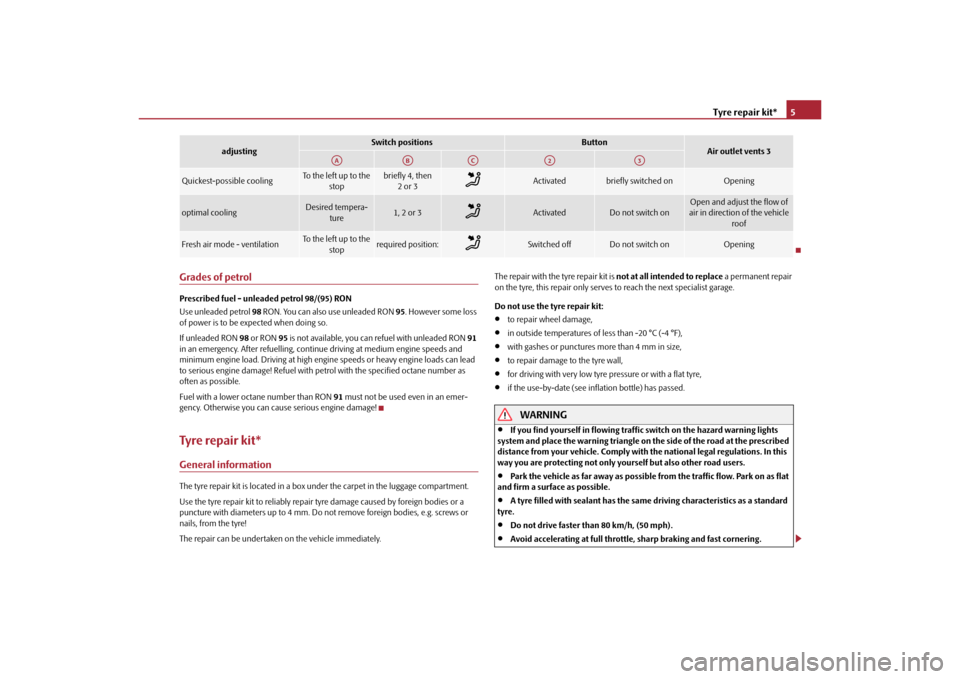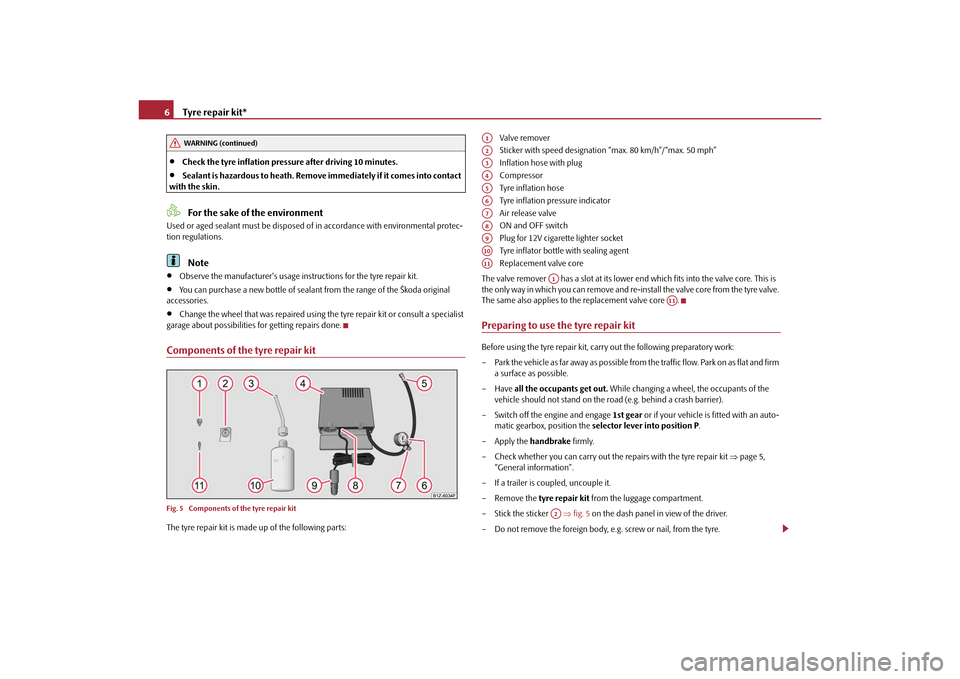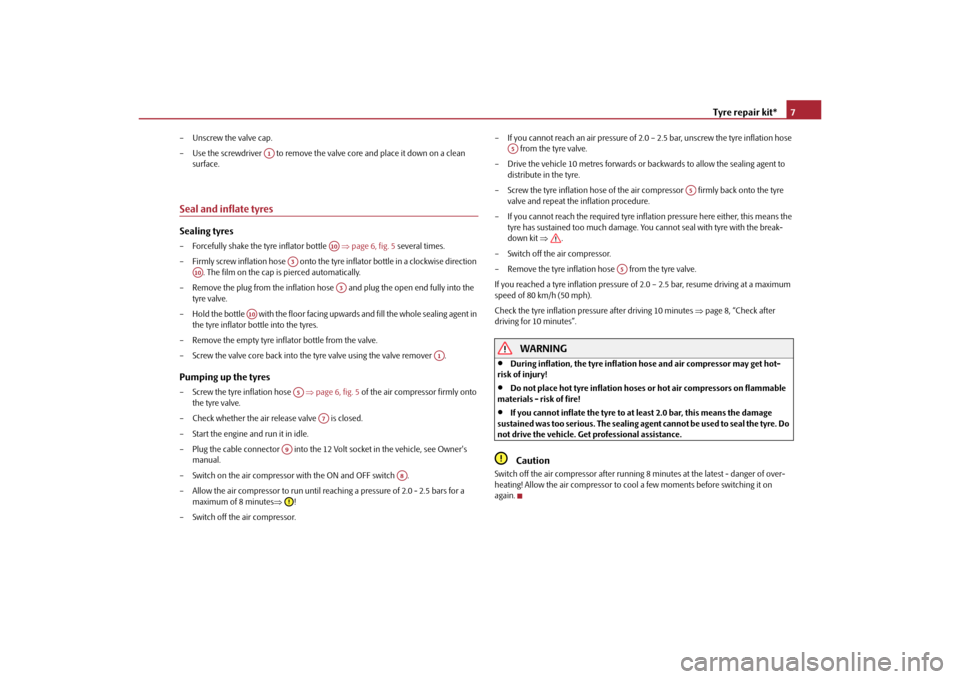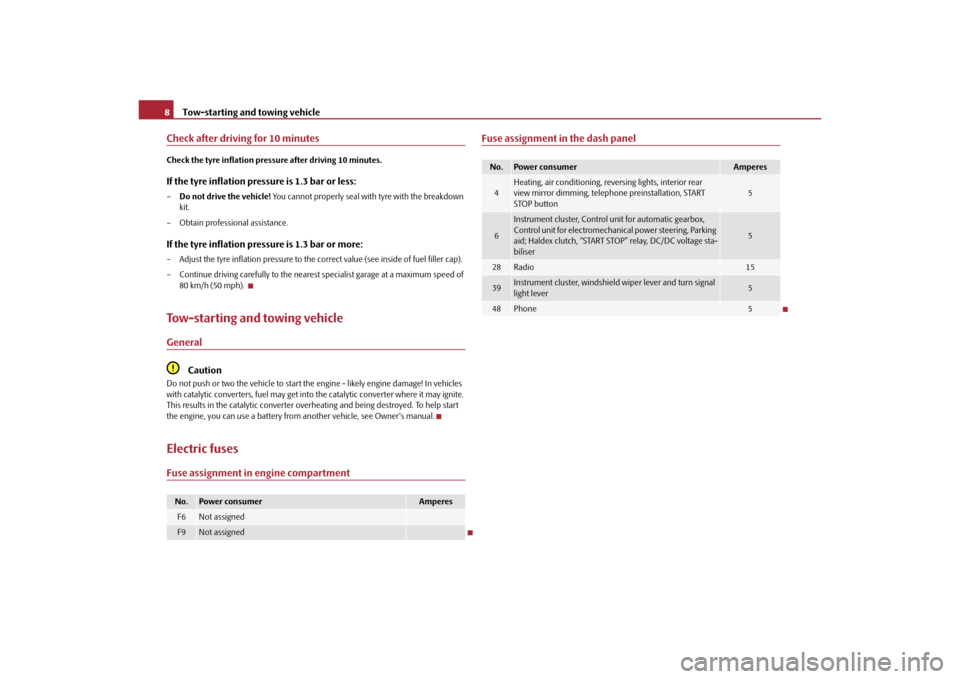inflation pressure SKODA OCTAVIA 2010 2.G / (1Z) Technical Change
[x] Cancel search | Manufacturer: SKODA, Model Year: 2010, Model line: OCTAVIA, Model: SKODA OCTAVIA 2010 2.G / (1Z)Pages: 22, PDF Size: 0.95 MB
Page 6 of 22

Tyre repair kit*5
Grades of petrolPrescribed fuel - unleaded petrol 98/(95) RON
Use unleaded petrol 98 RON. You can also use unleaded RON 95. However some loss
of power is to be expected when doing so.
If unleaded RON 98 or RON 95 is not available, you ca n refuel with unleaded RON 91
in an emergency. After refuelling, conti nue driving at medium engine speeds and
minimum engine load. Driving at high engine speeds or heavy engine loads can lead
to serious engine damage! Refuel with pe trol with the specified octane number as
often as possible.
Fuel with a lower octane number than RON 91 must not be used even in an emer-
gency. Otherwise you can ca use serious engine damage!Tyre repair kit*General informationThe tyre repair kit is located in a box und er the carpet in the luggage compartment.
Use the tyre repair kit to reliably repair tyre damage caused by foreign bodies or a
puncture with diameters up to 4 mm. Do no t remove foreign bodies, e.g. screws or
nails, from the tyre!
The repair can be undertaken on the vehicle immediately. The repair with the tyre repair kit is
not at all intended to replace a permanent repair
on the tyre, this repair only serves to reach the next specialist garage.
Do not use the tyre repair kit:
•
to repair wheel damage,
•
in outside temperatures of less than -20 °C (-4 °F),
•
with gashes or punctures more than 4 mm in size,
•
to repair damage to the tyre wall,
•
for driving with very low tyre pressure or with a flat tyre,
•
if the use-by-date (see inflation bottle) has passed.
WARNING
•
If you find yourself in flowing traffic switch on the hazard warning lights
system and place the warning triangle on the side of the road at the prescribed
distance from your vehicle. Comply with the national legal regulations. In this
way you are protecting not only yourself but also other road users.
•
Park the vehicle as far away as possible from the traffic flow. Park on as flat
and firm a surface as possible.
•
A tyre filled with sealant has the same driving characteristics as a standard
tyre.
•
Do not drive faster than 80 km/h, (50 mph).
•
Avoid accelerating at full throttle, sharp braking and fast cornering.
Quickest-possible cooling
To the left up to the stop
briefly 4, then 2or 3
Activated
briefly switched on
Opening
optimal cooling
Desired tempera- ture
1, 2 or 3
Activated
Do not switch on
Open and adjust the flow of
air in direction of the vehicle roof
Fresh air mode - ventilation
To the left up to the
stop
required position:
Switched off
Do not switch on
Opening
adjusting
Switch positions
Button
Air outlet vents 3
AA
AB
AC
A2
A3
s1ec.5.book Page 5 Friday, September 24, 2010 10:46 AM
Page 7 of 22

Tyre repair kit*
6
•
Check the tyre inflation pressure after driving 10 minutes.
•
Sealant is hazardous to heath. Remove immediately if it comes into contact
with the skin.For the sake of the environment
Used or aged sealant must be disposed of in accordance with environmental protec-
tion regulations.
Note
•
Observe the manufacturer's usage instructions for the tyre repair kit.
•
You can purchase a new bottle of sealant from the range of the Škoda original
accessories.
•
Change the wheel that was repaired using the tyre repair kit or consult a specialist
garage about possibilities for getting repairs done.
Components of the tyre repair kitFig. 5 Components of the tyre repair kitThe tyre repair kit is made up of the following parts: Valve remover
Sticker with speed designation “max. 80 km/h”/“max. 50 mph”
Inflation hose with plug
Compressor
Tyre inflation hose
Tyre inflation pressure indicator
Air release valve
ON and OFF switch
Plug for 12V cigarette lighter socket
Tyre inflator bottle with sealing agent
Replacement valve core
The valve remover has a slot at its lower end which fits into the valve core. This is
the only way in which you can remove and re-i nstall the valve core from the tyre valve.
The same also applies to the replacement valve core .
Preparing to use the tyre repair kitBefore using the tyre repair kit, carry out the following preparatory work:
– Park the vehicle as far away as possible from the traffic flow. Park on as flat and firm a surface as possible.
–Have all the occupants get out. While changing a wheel, the occupants of the
vehicle should not stand on the ro ad (e.g. behind a crash barrier).
– Switch off the engine and engage 1st gear or if your vehicle is fitted with an auto-
matic gearbox, position the selector lever into position P .
– Apply the handbrake firmly.
– Check whether you can carry out the repairs with the tyre repair kit page 5,
“General information”.
– If a trailer is coupled, uncouple it.
– Remove the tyre repair kit from the luggage compartment.
– Stick the sticker fig. 5 on the dash panel in view of the driver.
– Do not remove the foreign body, e.g. screw or nail, from the tyre.
WARNING (continued)
A1A2A3A4A5A6A7A8A9A10A11
A1
A11
A2
s1ec.5.book Page 6 Friday, September 24, 2010 10:46 AM
Page 8 of 22

Tyre repair kit*7
– Unscrew the valve cap.
– Use the screwdriver to remove the va lve core and place it down on a clean
surface.Seal and inflate tyresSealing tyres– Forcefully shake the tyre inflator bottle page 6, fig. 5 several times.
– Firmly screw inflation hose onto the tyre inflator bottle in a clockwise direction . The film on the cap is pierced automatically.
– Remove the plug from the inflation hose and plug the open end fully into the tyre valve.
– Hold the bottle with the floor facing up wards and fill the whole sealing agent in
the tyre inflator bottle into the tyres.
– Remove the empty tyre inflator bottle from the valve.
– Screw the valve core back into the tyre valve using the valve remover .Pumping up the tyres– Screw the tyre inflation hose page 6, fig. 5 of the air compressor firmly onto
the tyre valve.
– Check whether the air release valve is closed.
– Start the engine and run it in idle.
– Plug the cable connector into the 12 Vo lt socket in the vehicle, see Owner's
manual.
– Switch on the air compressor with the ON and OFF switch .
– Allow the air compressor to run until reac hing a pressure of 2.0 - 2.5 bars for a
maximum of 8 minutes !
– Switch off the air compressor. – If you cannot reach an air pressure of 2.0 – 2.5 bar, unscrew the tyre inflation hose
from the tyre valve.
– Drive the vehicle 10 metres forwards or backwards to allow the sealing agent to
distribute in the tyre.
– Screw the tyre inflation hose of the air compressor firmly back onto the tyre
valve and repeat the inflation procedure.
– If you cannot reach the required tyre inflation pressure here either, this means the tyre has sustained too much damage. You cannot seal with tyre with the break-
down kit .
– Switch off the air compressor.
– Remove the tyre inflation hose from the tyre valve.
If you reached a tyre inflation pressure of 2.0 – 2.5 bar, resume driving at a maximum
speed of 80 km/h (50 mph).
Check the tyre inflation pressure after driving 10 minutes page 8, “Check after
driving for 10 minutes”.
WARNING
•
During inflation, the tyre inflation hose and air compressor may get hot-
risk of injury!
•
Do not place hot tyre inflation hoses or hot air compressors on flammable
materials - risk of fire!
•
If you cannot inflate the tyre to at least 2.0 bar, this means the damage
sustained was too serious. The sealing agen t cannot be used to seal the tyre. Do
not drive the vehicle. Get professional assistance.Caution
Switch off the air compressor after running 8 minutes at the latest - danger of over-
heating! Allow the air compressor to cool a few moments before switching it on
again.
A1
A10
A3
A10
A3
A10
A1
A5
A7
A9
A8
A5
A5
A5
s1ec.5.book Page 7 Friday, September 24, 2010 10:46 AM
Page 9 of 22

Tow-starting and towing vehicle
8
Check after driving for 10 minutesCheck the tyre inflation pressu re after driving 10 minutes.If the tyre inflation pressure is 1.3 bar or less:–Do not drive the vehicle! You cannot properly seal wi th tyre with the breakdown
kit.
– Obtain professional assistance.If the tyre inflation pressure is 1.3 bar or more:– Adjust the tyre inflation pressure to the correct value (see inside of fuel filler cap).
– Continue driving carefully to the nearest specialist garage at a maximum speed of 80 km/h (50 mph). Tow-starting and towing vehicleGeneral
Caution
Do not push or two the vehicle to start the engine - likely engine damage! In vehicles
with catalytic converters, fuel may get into the catalytic converter where it may ignite.
This results in the catalytic converter overheating and being destroyed. To help start
the engine, you can use a battery from another vehicle, see Owner's manual.Electric fusesFuse assignment in engine compartment
Fuse assignment in the dash panel
No.
Power consumer
Amperes
F6
Not assigned
F9
Not assigned
No.
Power consumer
Amperes
4
Heating, air conditioning, reversing lights, interior rear
view mirror dimming, telephone preinstallation, START
STOP button
5
6
Instrument cluster, Control unit for automatic gearbox,
Control unit for electromechani cal power steering, Parking
aid; Haldex clutch, “START ST OP” relay, DC/DC voltage sta-
biliser
5
28
Radio
15
39
Instrument cluster, windshield wiper lever and turn signal
light lever
5
48
Phone
5
s1ec.5.book Page 8 Friday, September 24, 2010 10:46 AM